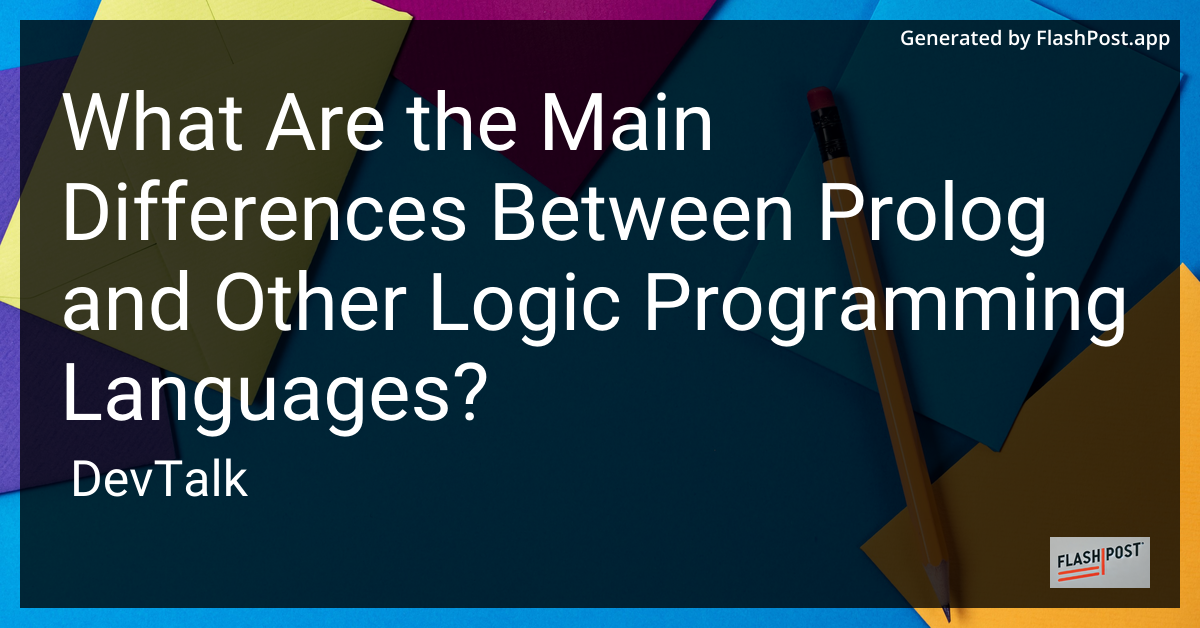What Are the Main Differences Between Prolog and Other Logic Programming Languages?

Understanding the Main Differences Between Prolog and Other Logic Programming Languages
Logic programming is a paradigm in which program statements express facts and rules about problems within a system of formal logic.
Among the many logic programming languages, Prolog stands out as one of the most prominent and widely used. This article will explore the main differences between Prolog and other logic programming languages, highlighting what makes Prolog unique.
Introduction to Logic Programming
Logic programming allows for computations based on formal logic. Programs written in these languages often specify what should be done, rather than how to do it. The computation is achieved through automated theorem proving. Logic programming is particularly useful in fields like artificial intelligence and computational linguistics, where complex problem-solving is required.
What is Prolog?
Prolog, short for "Programming in Logic," is a high-level programming language associated commonly with artificial intelligence and computational linguistics. It was developed in the 1970s and is based on a subset of predicate logic.
Key Features of Prolog
-
Declarative Nature: Prolog is inherently declarative, meaning it describes the logic of computation without outlining its control flow.
-
Facts, Rules, and Queries: Prolog programs consist of facts, rules, and queries. Facts are basic assertions, rules are deductions, and queries are questions regarding the information in the database.
-
Backtracking: Prolog uses backtracking as a method of finding all possible solutions to a query. It explores the space of potential solutions through depth-first search.
-
Pattern Matching: Prolog uses unification for pattern matching, a core aspect of its problem-solving ability.
-
Recursion: Extensively supports recursive predicates which allows naturally expressed logical sequences.
Differences Between Prolog and Other Logic Programming Languages
-
Syntax: While Prolog uses facts, rules, and queries, other logic programming languages may have different syntax and constructs. For instance, Datalog, another logic programming language, is a subset of Prolog with a focus on database queries and uses a more restricted syntax.
-
Execution Strategy: Prolog's execution model is based on SLD resolution, a method of backtracking. Other languages might employ different strategies. For example, Answer Set Programming (ASP) uses stable model semantics which is different from Prolog's approach.
-
Constraint Logic Programming (CLP): CLP extends logic programming by allowing constraints within logic programs. It has specific languages like CLP(R) and ECLiPSe, designed for various types of constraints, beyond what is typically straightforward in Prolog.
-
Typing: Prolog is typeless, meaning it does not require explicit declarations of variable types. Other logic languages, like Mercury, are strongly typed, requiring explicit typing and offering features like type inference.
-
Applications: While Prolog is versatile, it's mainly used in academic areas, linguistic processing, and AI-related tasks. Other language variants, specifically designed with enhancements, might offer better performance or features suited for specific domains, like database query languages in the case of Datalog.
Conclusion
Prolog's strengths lie in its simplicity and powerful pattern matching capabilities, making it the go-to choice for tasks involving AI and computational linguistics. However, other logic programming languages might be preferable depending on specific requirements like database handling or type safety. Understanding these differences can help developers choose the most appropriate language for their projects.
Explore More
- Learn to Create a List with Elements from 1 to N in Prolog
- Discover How Suffix Prefix Works Internally in Prolog
- Find Out How to Find the Max Number in a 2D Array in Prolog
- Explore How to Take a Procedure as Input in Prolog
- Learn How to Save Even Numbers in Prolog
By delving deeper into Prolog programming, you can better understand its unique capabilities and how they compare to other logic programming languages.